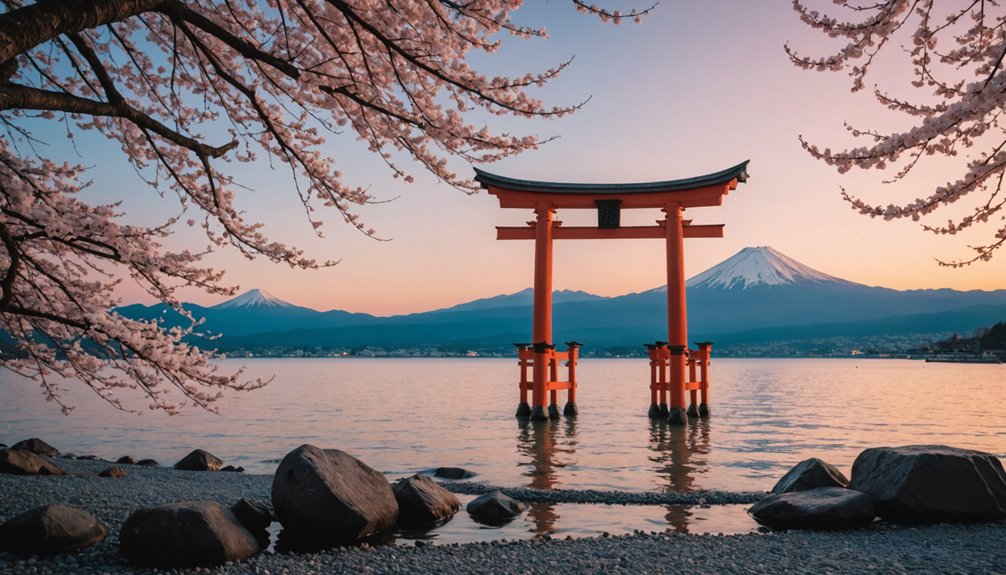I’ve traveled all over Japan, riding trains, exploring temples in Kyoto, and trying to order ramen in Japanese for the first time. I’ve learned that what makes a trip really special isn’t just the famous places, but knowing some little secrets that most guidebooks don’t tell you. Let me share what I wish I knew before I visited Japan for the first time.
Must-Visit Cities and Landmarks
Japan’s cities are full of amazing things to see and do. They mix old traditions with new technology, making them exciting for any traveler.
- Start your trip in Tokyo, where you can see famous places like Shibuya Crossing and the Imperial Palace.
- Then go to Kyoto to visit beautiful temples, the cool Arashiyama bamboo forest, and the Gion District, where geishas still perform their traditional arts.
- Be sure to visit Hiroshima’s Peace Memorial to learn about important history. If you like hidden treasures, check out Bitchu Matsuyama Castle, which is Japan’s tallest original castle and costs only 500 yen to enter.
- Nara is special because it has about 1,300 friendly deer wandering around freely.
- Osaka is famous for its amazing food scene.
- Mount Fuji is a giant mountain that reaches 3,776 meters, and Miyajima has a floating torii gate that makes for great photos.
Historic Sites and Cultural Heritage
When you visit Japan’s old historic sites, you’ll see how the country keeps its cultural traditions alive while also being modern.
I’m always surprised by how ancient temples sit next to tall skyscrapers, making a special kind of atmosphere you can’t find anywhere else.
In Kyoto’s Gion District, you can see traditional Japanese culture, where geishas still do their old-fashioned arts. The area’s buildings look like they did a long time ago, with wooden houses called machiya lining tiny streets.
Here are some of the most important historic places you should visit:
- Todai-ji Temple in Nara – Has Japan’s biggest wooden building and a giant bronze Buddha statue
- Itsukushima Shrine on Yajima – A UNESCO World Heritage site with a famous floating torii gate
- Bitchu Matsuyama Castle – Japan’s highest original castle, built at 430 meters above ground
These sites show how Japan works hard to keep its history alive for everyone in the future.
Natural Wonders and Outdoor Adventures
Japan has many beautiful natural places to see, beyond its famous temples and castles. One great spot is Mount Fuji. You can hike up it from July to September when the weather is best. Try to start early in the morning or even overnight so you can see the sunrise from the top, which is 3,776 meters high.
If you like wilderness and wild animals, visit Daisetsuzan National Park in Hokkaido. It’s a special place because it’s the only place in Japan where you might see brown bears. The trails are tough, but the views of the untouched nature are worth it.
Nikko National Park is easier to explore and has beautiful waterfalls and a summer palace used by the emperor. Near Miyajima Island, there are hiking trails that take you to great viewpoints above the famous floating torii gate.
In Kyoto, Arashiyama’s bamboo forest is a cool place to take photos, with tall green stalks all around.
Traditional Experiences and Local Culture
If you want to understand the real Japan, you should look beyond the tall buildings and speedy trains. Try to experience things that show Japan’s old traditions and culture.
In Kyoto’s Gion District, not only you can see what geisha life is like. The streets there have old-style buildings. You can also try making crafts like pottery or calligraphy, which are techniques people have been doing for hundreds of years.
Japan has many festivals that are fun and full of culture:
- Sapporo’s Snow Festival has amazing ice sculptures and draws more than two million visitors
- Kyoto has many celebrations all year round to show traditional Japanese customs
- In Ueno Park, people enjoy cherry blossom viewing, which combines enjoying nature with Japanese traditions
I’ve learned that when you take part in these traditions by visiting temples, joining festivals, or trying craft workshops, you get to see Japan’s true spirit in ways that just seeing tourist spots can’t show.
Seasonal Events and Festivals
Throughout the year, festivals and events happen in different seasons that turn cities and towns into lively celebrations. These festivals show how much Japan values nature and old traditions. If you want to see authentic Japanese culture, it’s a good idea to visit during these special times.
In February, there’s the Sapporo Snow Festival, where more than two million people see amazing ice sculptures. In April, you can enjoy cherry blossoms in Ueno Park, which has beautiful sakura trees that bloom in spring.
Kyoto has many cultural events all year, with traditions that are very important to the local people. These festivals are more than just fun to watch, they are ways Japan keeps its history and traditions alive.
Taking part in these celebrations can teach you a lot about how seasonal changes are important in daily life. Make sure to plan ahead because many festivals are very popular, and places to stay fill up quickly.
Food Scene and Culinary Delights
Japan has a lot of tasty food beyond just sushi and ramen, even though those are really popular. It’s a good idea to try regional dishes that show off the different flavors of Japan.
In Osaka, people call it the country’s kitchen because of all the yummy street food there. Some must-try snacks include:
- Okonomiyaki: A savory pancake with cabbage, meat, and seafood inside
- Kushikatsu: Skewers with vegetables and meat that are deep-fried
- Takoyaki: Small crispy balls filled with octopus, perfect for a quick snack
If you get a chance, take a sushi-making class at Tsukiji Market to learn how to make sushi the traditional way.
Make sure to try different types of ramen in various regions becasue each place has its own special broth and toppings.
Budget-Friendly Travel Strategies
Traveling in Japan doesn’t have to be super expensive. With some smart plans, you can see a lot without spending too much money.
Download the Navitime app so you can use offline maps and easily get around Japan’s great public transportation. Getting a JR Pass can also save you money if you plan to travel between cities a lot, since it gives you unlimited train rides.
When it comes to places to stay, hostels usually cost about 8,000 JPY per night. You can save even more by cooking your own meals in the hostel kitchens. You can also buy cheap pre-made meals at convenience stores like 7-Eleven.
After 8 PM, supermarkets often have discounts on fresh food. Some good ways to save are eating local dishes like curry, ramen, or donburi, shopping at 100-yen stores, and taking buses instead of trains.
Many places like Ueno Park and Nara’s deer, are free to visit and are really fun experiences that won’t cost anything.
Transportation and Getting Around
Getting around Japan is easy because they’ve a really good public transportation system. I suggest downloading the Navitime app before you go, so you can look at maps offline. This will help you a lot when you’re trying to find your way in stations.
If you plan to visit many cities, the JR Pass is a great deal. Here are some helpful tips:
- Trains: They’re the main way to get around. Trains are always on time, clean, and connect most cities.
- Buses: They’re cheaper than trains but slower. They’re good if you want to save money.
- Day trips: You can easily go on day trips from Tokyo, Kyoto, and Osaka using regional trains.
Public transportation works very well. Stations have signs in English, and IC cards like Suica or Pasmo work all over Japan. The system makes it easy for visitors to travel on their own, even if it’s their first time in Japan.
Safety Guidelines and Emergency Information
One of the reasons I love recommending Japan to travelers is because it’s very safe. Crime is very rare, so it’s a good place for people traveling alone, including women.
Still, it’s smart to stay alert and keep your belongings safe. The biggest dangers in Japan are natural disasters like earthquakes and typhoons, which happen from time to time.
If you need help, call 110 for police or use the Japan Helpline at 0570-000-911 for help in English. It’s also a good idea to buy travel insurance before your trip to stay protected. I recommend Seven Corners Trip Protection.
Again, download the Navitime app so you can find your way even without Wi-Fi, and save emergency numbers in your phone. Japan is very safe, but it’s always best to be prepared just in case something happens.
Accommodation Options for Every Budget
Finding a place to stay in Japan doesn’t have to be super expensive. There are options for every budget. Hostels are a good choice if you want to save money. They usually cost around 8,000 yen a day and have clean dorm rooms and sometimes kitchens so you can cook your own food.
If you have a little more to spend, budget hotels cost about 26,000 yen a day and include fun activities.
Here are some special types of places you might try:
- Capsule hotels: Small sleeping pods that are cheap and private in big cities
- Traditional ryokans: Japanese inns with tatami mats and futon beds for an authentic experience
- Luxury hotels: Fancy places in Tokyo and Kyoto with great service and amenities
It’s a good idea to book your stay early, especially during busy times like cherry blossom season in April or Sapporo’s Snow Festival in February, because prices can go up during those times.
I’ve got everything you need to explore Japan easily. From figuring out Tokyo’s subway to finding cheap ryokans to stay in. Think of this guide as your map; it’ll help you find your way, but the fun adventures are up to you. Whether you like visiting old temples, hiking mountains, or trying tasty food at local bars, Japan is amazing. Now, go ahead and book your flight so you can see it for yourself! See my post Top Travel Booking Sites You Need Now for the best sites to book your Japan adventures.


